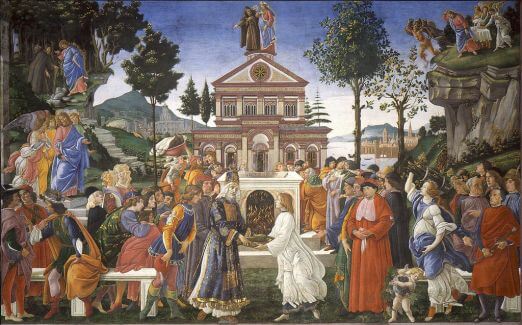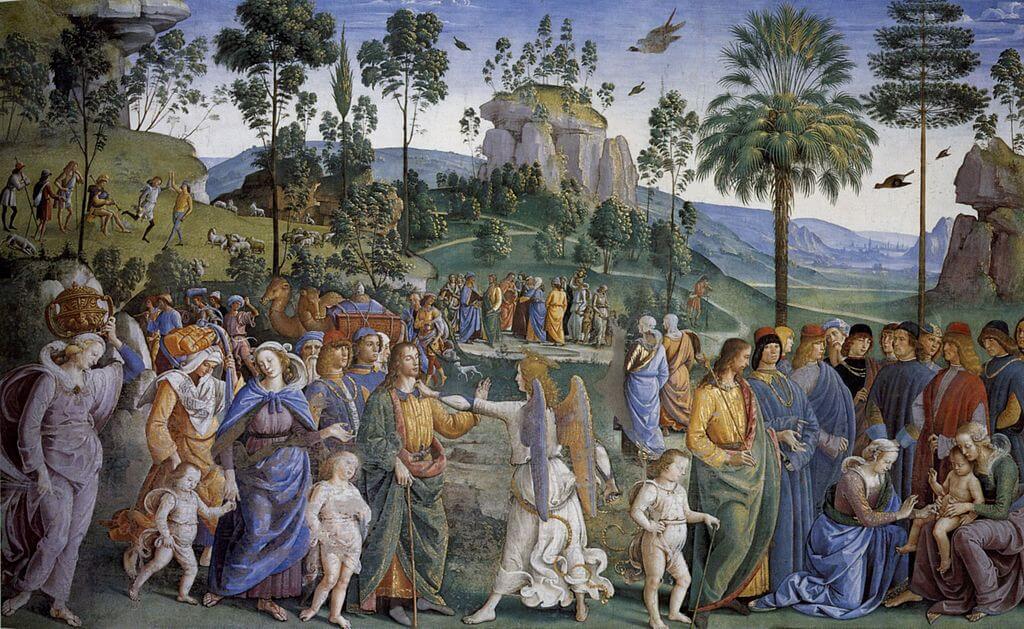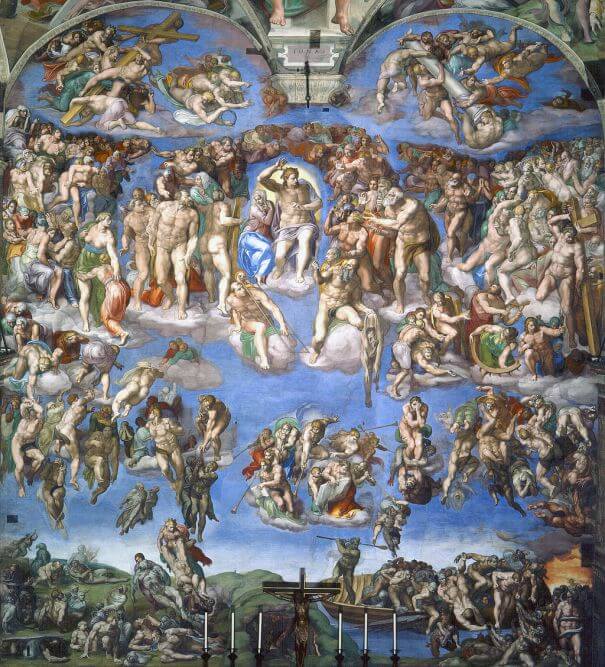|
Where? On the North wall of the Sistine Chapel in the Vatican Museums
When? 1482 Commissioned by? Pope Sixtus IV What do you see? This fresco illustrates four different scenes:
The baptism of Christ: The baptism of Christ is described in Matthew 3:13-17, Mark 1:9-11, and Luke 3:21-23. John the Baptist was baptizing people with water in the Jordan River. Jesus arrived there and asked John to baptize him as well. While John refused at first, Jesus convinced him that this was what God wanted. After Jesus was baptized, he came out of the water, and the Holy Spirit came down on him in the form of a dove. The dove said to Jesus: “You are my Son, the one I love. I am very pleased with you.” After that, the Holy Spirit sent Jesus into the desert for 40 days to prepare him for his public life. In John 1:29:34, John the Baptist also tells that he witnessed the Holy Spirit coming down on Jesus in the form of a dove. Backstory: This is the only work in the Sistine Chapel that is signed. Due to the large size of the fresco, and because Perugino was commissioned at least five other frescos in the Sistine Chapel (but only three survived), he used various assistants to help him . The best-known assistant was a young Pinturicchio, who continued to develop a successful career as a painter. Pinturicchio probably painted the landscape, and the scenes on the middle left and right. Surrounding frescos: The Baptism of Christ is the first out of seven frescos describing the life of Jesus. It is located on the right side of the North wall, directly next to The Last Judgment by Michelangelo. To the left is the second painting about the life of Jesus, which is Temptations of Christ by Botticelli. On the opposite wall are the seven frescos about the life of Moses. Some scenes from the life of Moses can be paired directly with scenes from the life of Jesus. In this case, the circumcision of the son of Moses in the right bottom of Moses Leaving to Egypt by Perugino is directly related to the baptism of Christ. Whereas in the Old Testament, circumcision of kids was the way to create a bond between God and the child, this was replaced by baptism in the New Testament.
Who is Perugino? Pietro Vannucci, better known as Pietro Perugino, was born around 1450 and died in 1523. Perugino was an apprentice of Del Verrocchio around the same time as painters like Leonardo da Vinci and Filippino Lippi.
Perugino was also the master of Raphael. He was one of the first Italian painters to use oil painting, a technique that was developed earlier that century by Jan van Eyck. In 1480, he was called to Rome by Pope Sixtus IV to paint several works in the Sistine Chapel. The most famous of his works is probably the Delivery of the Keys, which is also in the Sistine Chapel.
Fun fact: Perugino created six frescos in the Sistine Chapel. However, three of them have been removed to make place for The Last Judgment which Michelangelo painted between 1536 and 1541. It must not have been difficult for Michelangelo to remove the frescos of Perugino as Michelangelo was not a big fan of Perugino’s work.
The legend goes that Michelangelo told Perugino in his face that he was an amateur painter. Indeed, at the end of the 15th century, the career of Perugino went downhill, and he mainly repeated some of the compositions he had used earlier in his life. Interested in a Copy for Yourself? Poster or canvas.
0 Comments
|
Categories
All
|
- Home
- Blog
-
Museums
- Alte Pinakothek
- Art Institute of Chicago
- Baltimore Museum of Art
- Barber Institute of Fine Arts
- Bargello
- Barnes Foundation
- British Museum
- Church of Sant’Anastasia
- Cleveland Museum of Art
- Courtauld Institute of Art
- Detroit Institute of Arts
- Frans Hals Museum
- Galleria Borghese
- Gallerie dell'Accademia
- Getty Museum
- Guggenheim
- Hermitage Museum
- Kunsthistorisches Museum
- Kunstmuseum Basel
- Legion of Honor Museum
- Louvre
- Mauritshuis
- Metropolitan Museum of Art
- Musee d’Orsay
- Museum of Fine Arts in Boston
- Museum of Modern Art
- National Gallery in London
- National Gallery of Art
- National Museum in Poznań
- Norton Simon Museum
- Ny Carlsberg Glyptotek
- Palace of Versailles
- Palazzo Pitti
- Palazzo Vecchio
- Petit Palais
- Philadelphia Museum of Art
- Prado
- Pushkin Museum
- Ravenna Art Museum
- Rijksmuseum
- San Diego Museum of Art
- Santa Maria delle Grazie
- St. Peter's Basilica
- Städel Museum
- Statens Museum for Kunst
- Tate Britain
- Tate Modern
- Timken Museum of Art
- Uffizi
- Vatican Museums
- Wallace Collection
-
Artists
- Altdorfer
- Anguissola
- Berlin Painter
- Bosch
- Botticelli
- Boucher
- Bronzino
- Bruegel the Elder
- Brunelleschi
- Cabanel
- Caillebotte
- Canova
- Caravaggio
- Carpeaux
- Cezanne
- Cimabue
- David
- Degas
- Delacroix
- De Maria
- Donatello
- El Greco
- Fontana
- Fra Angelico
- Fragonard
- Gauguin
- Gentileschi
- Gericault
- Gonzalez-Torres
- Goya
- Hals
- Hogarth
- Hokusai
- Ingres
- Leonardo da Vinci
- Lippi, Filippo
- Longhi, Barbara
- Lorrain
- Makovsky
- Manet
- Massys
- Matisse
- Merian
- Michelangelo
- Mochi
- Modigliani
- Monet
- Panini
- Parmigianino
- Perugino
- Picasso
- Pisanello
- Raphael
- Rembrandt
- Renoir
- Reynolds
- Rivera
- Rodin
- Rubens
- Scultori
- Seurat
- Steen
- Tintoretto
- Titian
- Toulouse-Lautrec
- Turner
- Uccello
- Van der Weyden
- Van Dyck
- Van Eyck
- Van Gogh
- Van Hemessen
- Vasari
- Velazquez
- Vermeer
- Veronese
- Vigée Le Brun
-
Locations
- Books
- About Us





